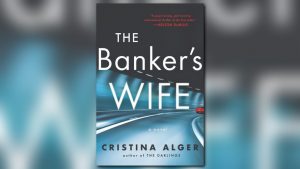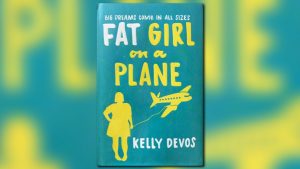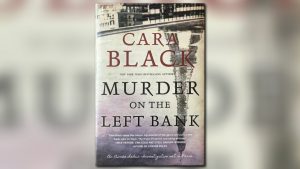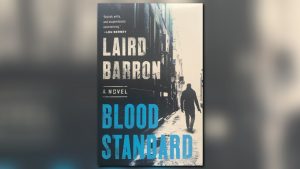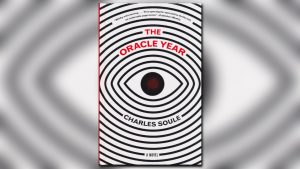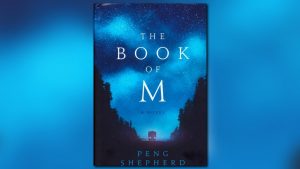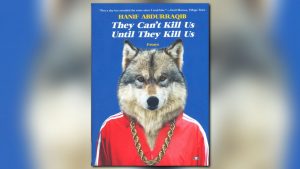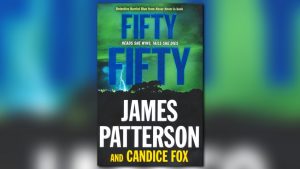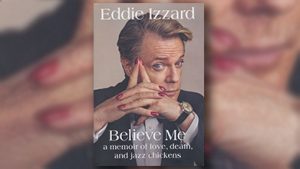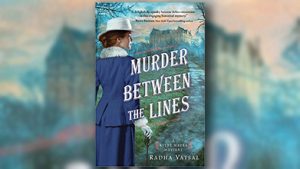The Eye of God is the next chapter of Rollins’ series, Sigma Force.
Sigma Force is an elite and covert arm of the Department of Defense’s DARPA unit.
The Sigma Force reveals an apocalyptic vision of a world doomed.
In the Eye of the God, Sigma Force is searching for a crashed U.S. military research satellite in the wilds of Mongolia.
The group is desperately searching for this satellite because of its last blurry image showing the eastern seaboard in United States in ruins.
James Rollins finds ways of using high concept scientific theories with historical and religious facts to redefine reality in the novel.
He also used medical and scientific knowledge with history and religion to create an exciting and fast-paced plot that is both informing and entertaining.
NARRATOR: And now an eight original production.
NARRATOR: "Books & Co." is made possible by the Virginia G. Piper Center for creative writing. Serving writers and readers in the Phoenix metropolitan area, the state of Arizona, and the world.
ALBERTO RIOS: Welcome to "Books & Co." Bienvenidos todos. I’m your host, Alberto Rios. And we're joined today by "New York Times" bestselling author James Rollins, who will be talking about his newest book, a recent Sigma Force novel, "The Eye of God." published by William Morrow. Welcome.
JAMES ROLLINS: Thank you.
ALBERTO RIOS: Sigma Force. I think we should probably talk about this more generally before we launch into the book. Because this is I think the ninth --
JAMES ROLLINS: Number nine.
ALBERTO RIOS: In a series based on this construct you have.
JAMES ROLLINS: Right. I have a team called Sigma Force, they're a group of ex-special forces soldiers that have been drummed out of the service for various reasons, and -- but they've shown some acuity, maybe high I.Q., special talent, so DARPA, which the defense department's research and development wing gathers them back up and says let's not lose these people, let's take the skill sets they have, retrain them in various discipline and have them basically used as field operatives to help protect against different types of global scientific and technological threats. I jokingly say they're basically scientists with guns. The short answer.
ALBERTO RIOS: I like it. Because this is part of a series, you are in a very privileged position. You can answer this -- this book then, number nine, should it be read in the context of the previous eight, or do you think it's a stand-alone?
JAMES ROLLINS: Great question. I always frame my story so they can be red in any order. I think the majority of my readers haven't read my series in order. they hop into different points and go back and forth and fill and they fill in the blanks where they can. Which I like. I want this series to be inviting to that new reader as it is satisfying to the reader that's been reading from the beginning. So I leave Easter eggs and character nuances that have read from the beginning, but if you're new to the series the action begins with enough information you're carried right into the story where there's never -- you don't need to read the previous books.
ALBERTO RIOS: You say action. Boy, isn't that what defines the book. It is action from beginning to end. Once you start you're basically at the end because you can't help it. It’s a vertex. I think that's a compliment to the book.
JAMES ROLLINS: I definitely try to make it a roller coaster ride.
ALBERTO RIOS: And you do it in a very interesting braiding way. You take these different strands, different stories, and they are quite a range, from all the way from historian, somebody with religious bent, astrophysicist, basically, you take these different stories and they each have a narrative and you braid them, and they get tighter and tighter until they're finally like a jigsaw puzzle. They all come together.
JAMES ROLLINS: When I’m usually pitching a concept to one of my editors, I’ll say I’m doing this, this, and this, and they'll say how do these connect together? I say, trust me, I’ll make it work.
ALBERTO RIOS: How do you do that? Do you have a big war room where you plot everything?
JAMES ROLLINS: I definitely have a bit of an outline, not as much as most people think. Most people think the story seems to be very -- has very many braidings, plot threads that have to all work together and the balls have to land just where you want them to land, but I generally just start with a loose outline. I know the beginning really well, I know the end really well, I know a few of the tent poles in between, but I don't know how a connects to b connects c necessarily when I start the novel. To me as a writer, one of the joys for me is to sit down and discover that story as I’m writing. If I had too detailed of an outline I don't think I’d want to write it. It’s like almost seeing a movie for a second time, it is not as enjoyable as the first time you see the movie. You might get some nuances but I like to have a little bit of -- not afraid of that blank screen. To me, the blank screen is a fun place to play because anything is possible.
ALBERTO RIOS: Anything in the book becomes possible.
JAMES ROLLINS: Sure.
ALBERTO RIOS: All sorts of things arise. That idea though, that invention, I’m intrigued. Just asking you as a writer, does it ever thud?
JAMES ROLLINS: Oh, yeah.
ALBERTO RIOS: As readers, we only read the good stuff.
JAMES ROLLINS: Yes. That's one danger of running -- running without a full detailed outline. Sometimes you will end up in funny places. Often times I’ll write my characters into a corner and I don't know how to get them out. To me that's ok. If I don't know how to get them out, neither does my reader. I think that's a good corner and I’ll struggle sometimes to get them out of the corner. But I’ve always got my antenna up for that next idea. I'm always looking for three elements when I am building a story. I’m looking for first location, I’d like to take my readers on a travel log around the world, showcase different spots, secret corners of the world. Then I’m looking for the historical mystery. That piece of history that ends in a question mark, maybe a mystery I can solve within the pages of the novel. I love talking to historians and just -- just checking to see what they might think about this and sometimes I’d go with what they say, sometimes I don't. The third element is science. I'm always looking for that cutting edge bit of technology that I can -- that makes me go what if, or gee whiz, and where I might be able to take it. And the key is trying to find those elements that blend together. That's a challenging part. I've got a cardboard file box at my house, and I watch different channels and I watch discovery channel, national geographic, and if a topic comes up, I jot a note and throw in the box, if I’m reading Scientific America or Smithsonian, I’ll cut out an article, it goes in the box. It's chaotic, it's messy, there's probably mice burrowing somewhere down at the bottom. But I like that chaos. What happens is that it's a great germinator. What I have to do, because it gets full, so occasionally I’ll have to empty it. So in the middle of my living room floor, dump it out, I sift through and look for old ideas that maybe no longer interest me, or maybe somebody else already tackled that idea so I can get rid of it. Otherwise one box becomes two boxes, before you now it James Rollins on hoarder. So I keep to it one box. So what happens, I dump that over, and a lot of times that piece of science or history will land on the floor next to each other and I’ll look at them and only then do I make that connection. Nowhere in my head would I have connected those together. Just because visually they happen to be on the floor next to each other, I’ll begin to see threads that come together. Often times I’ll follow those threads and it will dry up. But other times it builds and I can almost sense, I can feel a story building. Then I’ll know something is there. But 90 days or so I’ll research that topic, those three things, the location, the science and history, and make sure there's a plot. So I put about 90 days doing that, and the 91st day I have to start writing, otherwise I’ll keep researching and I’ll think I’m working but I’m not. The 91st day it's time to put words on the page.
ALBERTO RIOS: You're kind of describing a text mosaic. Just dumping all these colors onto the --
JAMES ROLLINS: That's a good analogy.
ALBERTO RIOS: You're coming up with this great image that is finally provoked out of all of those juxtapositions.
JAMES ROLLINS: There's so many -- people say aren't you going to run out of ideas? No way. There's so many historical mysteries waiting to be solved, and there's so many bits of science I’m fascinated by. There's always things that will meld together to become my next novel.
ALBERTO RIOS: Are you a globetrotter yourself, out of curiosity?
JAMES ROLLINS: I do. I try to -- I did a spreadsheet at one point, I have questions asked at book signings, how many places that you've written about have you visited? Roughly it's about 80%. A fair number of the places I’ve visited, even this novel, part of it takes place in Hong Kong Macau, I’ve been there, part of it takes place in the capital city of Mongolia and sort of in the rural area of Mongolia, I had a trip out there. Part of it takes place in North Korea, I have not been there. I talked to some people that managed to escape out of North Korea to prepare for this novel, but that's one place I’ve not traveled to and I’m not particularly keen on it, I don't think I want to travel there.
ALBERTO RIOS: The cold, just the way you described that and the underground, I’m sure you get this all on good information. It's ominous. To say the least. Well, all of this is -- that willingness to travel is also an intellectual endeavor in the book. You're not afraid to travel in any direction, including into the far reaches of science, the far reaches of history as you're describing. When you do this, you're playing with some things that are cutting edge. Very current. Very interesting, and engaging. Things like entanglement, for example. Do you want to talk about some of these ideas?
JAMES ROLLINS: Sure.
ALBERTO RIOS: Entanglement play as big role in the book. I'm not giving anything away.
JAMES ROLLINS: It does. We're sort of the -- where the seed for this book came from, I visited, I was invited to visit Fermi lab, which is a National Particle Accelerator lab outside of Chicago, and it was great being able to see some of the high-level physics going on in that research facility, I got to meet the physicists, and over lunchtime we're seated around a table, and I asked a question, I asked a lot of the researchers and scientists I encountered in my interview process, and I asked them to tell me something that scares you. Tell me something about your research that keeps you up at night. And unfortunately they did. After a little indigestion I thought maybe there's a story here. What they were describing to me at that point, this is something you can now read in the news, but back when I was first forming it was very new at the time. There's a new supposition the universe we're living in today, potentially is literally a hologram, that nothing is real. Nothing is substantial, it's all basically lights and mirrors and shadows. When this was proposed to me I’m thinking, that sounds like science fiction and that sounds unrealistic. And I challenged the physicist as though I have the right to do so, I said, that just sounds crazy. He goes, actually most of the mathematical theory, a lot of physicist and mathematicians have studied why we believe this to be so and most accept probably theoretically it is valid. Now what they're doing this year, which is on the creepy side, they're building a holometer, they are actually building a device that's going to test to see if with we're actually living in a hologram. And they'll expand from there and go to the possibility of multiple universes, and how we're all connected, you talk about quantum entanglement. It’s a weird process, physicists always thought this was only in the subatomic level. You can take two particles that are interacting, and when they separate in the right conditions, they'll actually be quantumly entangled. You change this one, this one changes spontaneously, even across vast vast differences.
ALBERTO RIOS: Which is hard for us to get.
JAMES ROLLINS: Exactly, it seems again something out of science fiction, but it's proven in the lab to be true. But they've always thought it was at the subatomic level and it took super cold temperatures to achieve. But a pair Chinese scientist produced two diamonds that you can see with the visible -- unaided eye at room temperature, were able to show they also shared this quantum entanglement. So they were able to create quantum entanglement with things you can see with the visible eye. So that's -- it seems farfetched, it seemed wild, like it's something out of science fiction, but it's valid.
ALBERTO RIOS: It's odd for us, here we are in the 21st century and we're still invoking Einstein and a lot of things he was saying about this kind of science.
JAMES ROLLINS: Even he thought quantum mechanics was probably spooky.
ALBERTO RIOS: That's exactly the word he used.
JAMES ROLLINS: It seems pretty odd.
ALBERTO RIOS: It scared him.
JAMES ROLLINS: One, I love this fact-- Brain Green, another physicist, uses this example of how unsubstantial reality is. Here I am, I clock in at about 200 pounds. Which I think is -- I’ve got some mass, I’ve got some substance here. But how much of that is real? And he uses an example, here you've got, you're made up of atoms, and atoms are composed of very simple things. A solid nucleus with electrons spinning around it. There's some dead space in there. Brain Green said if you took off all the dead space with an atom and shrunk it down to the core essential mass, how small would you be? This is the -- this is what sort of freaked me out. He said if you took everybody living on the planet today, everybody that lived on the planet in the past, every single human that ever existed on earth, took all the dead air out and shrunk them down to their primary mass, we would all fit in the size of a baseball.
ALBERTO RIOS: Wow!
JAMES ROLLINS: So even though I look like 200 pounds, that solid mass of me --
ALBERTO RIOS: All of us in combination.
JAMES ROLLINS: All of us in combination. Every single one of us would fit in a group, crammed into --
ALBERTO RIOS: A true mass.
JAMES ROLLINS: It fit inside of a baseball. That's how much of us is basically hot air, for lack of a better term.
ALBERTO RIOS: I'd like to just take a moment and reintroduce the program, this is -- you're watching "Books & Co.," we're joined today by author James Rollins., talking about his book “The Eye of God”. I'm your host, Alberto Rios. And as we're talking about this, the surrealists wrestle with that same notion, they called it dream. Everybody has a different sort of word for something, but everybody knows there's something else out there or in there.
JAMES ROLLINS: Even today scientists are still grappling with what is human consciousness. Where is the seed of human consciousness? Is it in the brain, is it somewhere else? Most biologists -- neurobiologists the brain works as a quantum computer and our consciousness probably lies in the quantum sphere. Which is a weird concept, it may even be in us, it's sort of around us a little bit. So to me I’m fascinated by the fact we've again in the past we've had people that believe that potentially there are -- our consciousness is not within our body, we can move and shift consciousness, and maybe they're right. Maybe we haven't discovered them yet.
ALBERTO RIOS: What's great about this in the book, you make a story out of science. And you give us something to go on beyond just simply facts and figures. We're enthralled with making all of that turn into something. And I don't want to give anything away, but the plot of the book is, there's a major disaster potentially in order, going to happen, and maybe you would like to talk about the book?
JAMES ROLLINS: The book opens, the very beginning of the book, there's a military research satellite that's been examining a comet passing by earth --
ALBERTO RIOS: And there is one coming.
JAMES ROLLINS: And there is one coming. I like to ground my story if I can in a real moment. So there really is this big comet, comet Ison, it's going to be coming past Earth this November, it's going to be a fairly big, it's going to be a large celestial event. This comet is going to be so bright it's going to outshine the moon and be bright enough you can see it during the day. So comets have also historically been harbingers of doom. The appearances of comets are supposedly, predicted the bubonic plague or the battle of Hastings or even the death of Mark Twain. So, thriller writer here, I learn of this big comet that's coming this November and I’m going to try to tie a great bit of doom around that if I can. So I thought I’m going to borrow that comet. So here we have this research satellite that is examining this comet that is coming, and it begins to fall out of orbit. And I won't tell you why. And it's burning through the upper atmosphere. It happens to capture one final image that it's burned away. And the final image that is send back to Earth is of the eastern seaboard, the eastern seaboard is in utter ruins, it's smoldering, on fire, it's destroyed. Now the question that is -- where did this picture come from? Is it a fluke, is it a glimpse of what's to come? To discover the truth, Sigma Force, my group of soldier scientist head out to find the wreckage, which is crashed in the wilds of Mongolia, and what they discover is a larger threat, a threat that actually is a danger to all humanity.
ALBERTO RIOS: What's interesting to me, describing that, where did that picture come from? We make movies of that. We have all of this -- what we think of as work a day things,--
JAMES ROLLINS: Right.
ALBERTO RIOS: -- going to the movies, reading a book. But we're dealing with those alternate possibilities all the time.
JAMES ROLLINS: Exactly.
ALBERTO RIOS: And I think the books takes good notice of that. You mention the comet being a harbinger of doom, but it also became personal to different people. You talk about Mark Twain, but you're also referring to Genghis Kahn.
JAMES ROLLINS: Because I wanted to set the story in Mongolia, and that I had visited there and I was fascinated by the culture and the society and the way they are trying, it’s fascinating country. The capital city is the coldest capital city, they have steam tunnels that try to keep the city warm, and there's a whole populous that lives in the steam tunnels, the equivalent of the homeless. I got to interview people out there, in the city and rural areas, and I found the way they sort of have a demigod worship of Genghis Kahn, what I found out, tied to the comet, basically is that supposedly Haley’s comet appeared during Genghis Kahn's life, and he believed that was a sign to head west and invade most of the known world.
ALBERTO RIOS: Was heading that way, or he perceived it that way.
JAMES ROLLINS: Exactly. He figured it was his signal from the stars to head in that direction. But Genghis Kahn is a fascinating figure. He conquered most of the known world, vast wealth flowed into Mongolia and vanished theoretically in his tomb, which has never been discovered. Speaking of some of the -- to some of the locals, something you learn boots on the ground talking to people there, talking about Genghis Kahn’s tomb, they're like, oh, we don't talk about that. Why don't we talk about Genghis Kahn's tomb? We have this supposition that if Genghis Kahn's tomb is ever found and opened, it marks the end of the world. I'm going, ok, really? As a thriller writer, I’m thinking I can use this information.
ALBERTO RIOS: As you do. You talk about other things as well. We've got maybe the more extremes, like entanglement, but you also talk about things that seem a little closer to what's happening, bio hacking, for example. Maybe you could talk about your interest in bio hacking.
JAMES ROLLINS: I attended a body modification fair in San Francisco, where I was just looking for maybe an interesting character that could pop into a novel.
ALBERTO RIOS: Have you that great phrase, the guy that does this likes to call himself an evolutionary artist.
JAMES ROLLINS: Exactly. I didn't make that -- I borrowed that from somebody who considered himself to be an evolutionary artist. Basically trying to meld technology and biology together. And so I was just wandering through this fair and seeing a lot of strange things, I saw this one gentleman getting operated on his finger and I was curious about what he was doing. What he was having done was having these rice-sized particles of rare earth magnets placed in his fingertips near the somatic sensory nerve in your fingertip, and I was thinking, what are you doing that for? He said in the presence of an electrical field, this magnet will vibrate and it will stimulate the nerve. And so it will have a very unique sensation. So I have it done to all my fingertips so I can sense electrical fields. I was fascinated. So it wasn't just him, there were a couple other people having magnets replaced or having it done for the first time. They describe it almost as opening up a third eye. Opening up another sense that's never been out there before. And they describe this electrical field as having texture and rhythm, and heat, and one gentleman said, I even define different colors to these electrical fields. And I said, what do you mean by color? He said, hard to explain, but trying to explain what color blue to a blind person, who has never seen the color blue. I can't describe what I mean by color, but that's the closest word I can come up with to describe this. I thought, this is fascinating. Are you doing that for the fun of it, or because you want to feel these things? He said, no, there's some practical uses for these magnetic fingertips. Very weak magnets, you're not going to stick to the side of a refrigerator, and it's so small you won't set off alarms in TSA. But what it will allow to you do, these people can actually sense, like when you're hard disk is not spinning correctly in a laptop without opening it, another gentleman uses it when he repairs his cars, because he can tell when the carburetor is not functioning, which spark plugs aren't hitting the right note. People describe it as walking down the street, there's a whole electromagnetic world out there that we're blind to. They can sense it. I thought I’m going to -- one of my characters will have that.
ALBERTO RIOS: Absolutely. You talk about putting science into the body. You also have some reciprocity in that you also talk about putting the body on to things. You call it Anthropodermic Bibliopegy. Which is a practice and you make use of it. I saw it as counter point to the magnets, back and forth. Do you want to explain what that term means?
JAMES ROLLINS: It's basically and again I am not ruining too much as it happened right in the beginning of the novel. One of my characters, he is a vatican archeologist, receives this package in the mail, it's from an archaeologist he believes passed away a decade ago and vanished. Inside are that package is a skull, an ancient skull, that has some Jewish aramics inscribed on it, but there's text wrapped in human skin. And that was sort of -- not uncommon source of material for binding books in the past. I was shocked to find out how often that was done. They found an astronomical treatises that are bound in skin, that have found anatomical books bounded in human skin. They have found prayer books and holy books bound in human skin which seems almost sacrilegious. There's a book that is bound in someone -- we could see the person's face. I was -- it's macabre, I was fascinated by why they would be doing this, and that becomes a critical element to the story.
ALBERTO RIOS: It also suggests preciousness or something of importance. I guess I can see that particular sort of connection. I want to make sure we don't let this session go by without talking about your original training. Were you trained originally as a vet. Could you talk about that?
JAMES ROLLINS: Veterinarian, I should qualify that, there's --
ALBERTO RIOS: That's true.
JAMES ROLLINS: I always wanted to be a veterinarian, I got that assignment that you usually get in third grade, what you do you want to be when you grow up, I remember sitting -- probably a moral dilemma, I was sitting in my desk with a blank sheet of paper, knew I wanted to fill out the essay as veterinarian. Didn't know how to spell it. So I did the one thing all third graders hate to do, I went and got the dictionary and looked it up. I was determined to be a veterinarian. I've loved animals, loved science, loved medicines always have, you'll see that in my writing. You'll see a lot of medicine, animals appear in my books, I’ve had military war dogs as main characters, in this book there's a pesky falcon that plays a key role and a freshwater seal that plays a role. So I love to blend my old profession and my new profession. So this was one side of my brain that loves science animals, and this side of my brain that's more twisted, more crazy. I was raised Polish Roman Catholic so I have three brothers and three sisters, and to have the Polish flag in the window had you to have at least seven kids, she had a spare. They're my early audience. And my goal growing up was to be the storyteller. I was always trying to see what I could convince my younger brothers, the more tears involved in telling a story the better. I call it storytelling, my mom called it lying. So eventually I read a lot, and that was like throwing gasoline on the twisted corner of my mind.
ALBERTO RIOS: That's the writer talking.
JAMES ROLLINS: Exactly. Dabbling with short stories essentially, and eventually branch in addition books, my books began to sell, my clients began to ask me, you had successful veterinarian clinic, why are you write now, I had posters in my lobby, get your cat spayed get a free book. So the questions began to arise, and I said, for 20 years now my veterinarian degree was my paycheck. My writing was my hobby. I thought it would be cool to flip that around and have writing shall my paycheck and now I use my veterinary degree as a hobby. I work with a group that traps feral cats in the local area, and I spay and neuter them one Sunday a month for about eight hours and they're rereleased where they're trapped. So I keep my -- I like to be -- my claim to fame is I can still neuter a cat in under 30 seconds.
ALBERTO RIOS: Something for an author to be able to do.
JAMES ROLLINS: Exactly.
ALBERTO RIOS: I want to end by pointing -- there's so much action in the book, but you occasion hit a moment that is memorable, you have one of my favorite happens near the end, these are just images. They're not for the sake of the plot. Or the action, just a great image. You have a character out in the parking lot, the narrator is out in the parking lot, his black Mustang Cobra R, do you remember this? Do you want to say it? Shown like a polished piece of shadow. It’s a great image. You have some other moments that are equally intriguing. You have one character who has lost her way so many times, she says, am I just scar tissue and instinct? Some great language.
JAMES ROLLINS: I love her. She's -- from the beginning of the book to -- the beginning of the series until now we see her have an arc to the book. I mentioned before haven some nuance between the first book --
ALBERTO RIOS: She's a good example.
JAMES ROLLINS: She's a good example for getting some nuance.
ALBERTO RIOS: Ok. I want to thank you for joining us today.
JAMES ROLLINS: It's been a lot of fun. Thank you.
ALBERTO RIOS: I want to thank our audience for joining us. We've been talking today with author James Rollins., who has been discussing his book “The Eye of God”. A Sigma Force book, and I know it's going to do well. I'm your host, Alberto Rios. Please join us again next time when we'll be bringing you another good book.
NARRATOR: "Books & Co." is made possible by the Virginia G. Piper Center for Creative writing. Serving writers and readers in the Phoenix metropolitan area and throughout Arizona.










